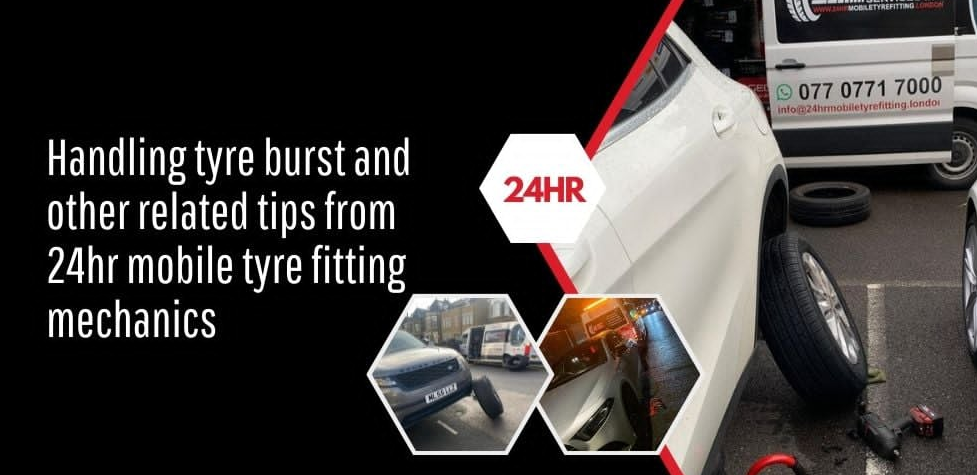Tire burst and other related tips from 24-hour mobile tire fitting mechanics

A sudden tire burst while driving can pose a severe risk to all passengers. Regular tire maintenance and proactive knowledge can help minimize this danger.
In the following blog post sections, let us explore the basics of dealing with a sudden tire burst. Everyone who drives a vehicle must have this basic knowledge or information.
What you should do in case a tire bursts while you are driving
When a tire suddenly bursts while driving, the instinctive reaction is to put on the brakes. But experienced car tire mechanics in London opine that is the one thing you must avoid in these circumstances. Instead of slamming on the brake paddle, you should do the following in the situation of a tire burst while driving on the road:
- Secure a firm grip on the steering wheel
- Apply the brake gently
- Turn on the danger lights on the vehicle
- Gently maneuver your vehicle off the side of the road before calling a mobile tire mechanic to come for help.
A tire burst while driving on the road is potentially hazardous for every passenger in the vehicle. But the main danger in these situations lies if the driver panics and slams hard on the brakes.
If you slam on the brake pedal in such circumstances, the vehicle may flip over and swing into oncoming traffic. This is why pressing the brake is a strict no-no in these conditions. When you apply the brake in a moving car, the brakes on both sides of the vehicle come into action.
But if a tree on one of the sides is no longer providing any grip on the road (as it has burst), then the vehicle experiences a sudden imbalance of force, explains a mechanic who has dealt with 24-hour mobile tire fitting in London over the years. Let us discuss this sudden force imbalance in the vehicle in more detail.
As you apply the brake, the force of the brake works on the two wheels at the front of the vehicle. Suppose the front left tire is blown; in that case, the vehicle’s rear keeps pushing forward because of the already built-up momentum, which is critical in auto-transport scenarios.
However, since the front left tire is blown, the remaining right front tire can only resist the momentum on the right side of the car. Thus, the vehicle has a high chance of tailing fish on the right, and the back swings across the other road lane.
In the case of a blown tire, when you apply the brakes gently, the dynamics of auto transporting can lead to a loss of control, making it essential to understand how to manage such situations effectively.”
It enables you to counter-steer and maintain balance until your vehicle reaches a speed at which you can safely pull over at a spot.
After reaching a safe place after a tire bursts, the first thing you should do
After pulling the vehicle over to a safe place, you have two options: swap the punctured tire with a spare or call a roadside assistance service nearby. Be careful of the steel wires that may be exposed at the point of a tire burst. Due to the burst pulling them apart, the edges of these wires can be razor sharp. If you are cautious, you can save yourself from a nasty cut.
Preventing tire bursts: a few things to remember
Tires are designed to withstand anything encountered on the road, including hitting innumerable potholes (and hitting them really hard) in succession. This may not result in a complete blowout but may create a tiny puncture, which results in fast deflation.
These conditions are much easier to tackle; you can pull over the vehicle at a safe place and replace the deflated one with a spare, or you can call roadside assistance.
Besides exceptional impairment, a tire blowout usually occurs when a vehicle is massively overloaded, or its tires are not properly checked and maintained regularly. Because of the accumulation of impacts,
Usually, tire sidewalls weaken, and as that weakened area gets knocked, the rubber becomes thinner and weaker. Finally, the tire bulges out at the sidewalls. Having your tires checked by skilled and experienced experts at regular intervals is extremely important.
Checking this around the whole length of the tire’s face suggests a mechanic who has provided 24-hour mobile tire fittings for years. Any damage sustained on the inner wall of a tire usually goes undetected. Regular tire servicing from skilled and reliable experts proves helpful in identifying potential problems before they turn into real issues.
Tire pressure checking
According to experts, the problem of pressure is easy to address. Tyre pressure varies throughout the year and the seasons, which is quite evident. It also fluctuates overtime every day because of the temperature difference between day and night.
But that does not mean you can let the pressure get excessively low or set it to an excessive high. You will wear out prematurely, leading to higher fuel consumption and repeated tire-blowing occurrences in both conditions.
Investing in premium brands of tires is always better. Tire bursts are rare, with premium-quality tires provided by renowned brands. According to mobile tire fitting experts at Golders Green,
Premium-quality tires offer a load of benefits, which include much better grip on the road surface, higher fuel efficiency of your vehicle, greater comfort level, and, most importantly, much less wear and tear.



